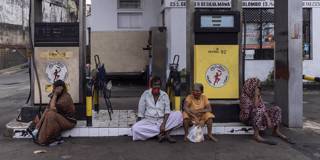XU QIYUAN and WAN TAILEI

BEIJING – Many developing countries are teetering on the edge of a debt crisis, with the COVID-19 pandemic, soaring food and energy costs, and the monetary tightening of major economies all threatening to push them over. But the international community has yet to do what is necessary to pull at-risk countries back from the brink.
For some economies, such as Lebanon and Sri Lanka, the crisis has already arrived. They could soon be joined by many more. As of the end of March, 38 of 69 low-income countries were either already in or at high risk of debt distress. Middle-income developing countries’ debt-service burden is at its highest level in 30 years.
The international community has taken some action in response to the problem. Soon after the pandemic began, the G20 introduced the Debt Service Suspension Initiative (DSSI), under which $12.9 billion in payments owed by 73 low-income countries was suspended between May 2020 and December 2021. Moreover, in November 2020, the G20, together with the Paris Club of sovereign creditors, created the Common Framework for Debt Treatments Beyond the DSSI to help DSSI countries restructure their debt and manage insolvency and protracted liquidity problems.
But these initiatives are nowhere near enough to resolve developing economies’ debt problems. One problem is stigma: When a debtor resorts to the Common Framework, it can face a sovereign credit downgrade. Most countries are not willing to take that risk, especially given the initiative’s limited scope.
Moreover, although the Common Framework relies mainly on official creditors' support, private creditors own the majority (60%) of the claims. The perception that private creditors are freeriding could discourage official creditors from accepting more debtor-friendly terms. And debtor countries know that they will still have their burdens of private debt to deal with even if they undergo a Common Framework restructuring. It is little wonder that only three debtor countries have so far applied to restructure their debt under the Common Framework.
There is a better way. In August 2021, the International Monetary Fund approved a general allocation of $650 billion in special drawing rights (SDRs, the IMF’s reserve asset), which was distributed to member countries in proportion to their quota shares. If used wisely, these funds can go a long way toward supporting indebted countries.
The obvious proposal would be for countries with idle SDRs simply to donate them to struggling countries. But, beyond the risk of moral hazard, this approach is unlikely to produce enough funds to make much difference. After all, loan commitments to the IMF’s Poverty Reduction and Growth Trust (PRGT) totaled just $7.8 billion in 2021. That is better than nothing, but still far from adequate.
To make a real difference, SDRs must be used more imaginatively. Developing economies suffer from the so-called original sin problem, meaning that they cannot borrow abroad in their own currency. Moreover, they often struggle to borrow in international bond markets, owing to weak sovereign credit ratings. But if SDRs were used to boost their credit ratings, private investment could be leveraged to tackle high debts.
The first step would be for the IMF to borrow interest-free SDRs from member countries, and put them into a trust – whether the PRGT, the Resilience and Sustainability Trust, or a new entity. Next, debtor and creditor countries would jointly apply for SDR loans from the trust, or a debtor country would apply alone before negotiating terms with its creditors.
Either way, the application process would be open, transparent, and market-based. The IMF could work with creditor and debtor countries to establish a reporting mechanism that covers all debt claims and relevant data. Participants would cooperate to ensure that the debt restructuring followed best practices and met transparency standards.
Once the application was approved, the IMF trust would extend a concessional SDR loan to the debtor country, with a very low – even zero – interest rate. Since the SDR is neither a currency nor a claim on the Fund, borrowers would then convert the funds into one of the asset’s five constituent currencies – the US dollar, the euro, the Chinese renminbi, the Japanese yen, or the British pound – which would be used to purchase high-rated government bonds issued by reserve-currency countries. With these risk-free assets as collateral, debtor countries could then issue “international anti-epidemic cooperation bonds,” using the proceeds to roll over or repay debt.
Such a credit-enhancement program – which is consistent with the Common Framework – would ease liquidity pressures and reduce debt risks while avoiding moral hazard. More important, it would spur the private sector to participate actively in the debt-restructuring process and boost the resources being channeled toward development financing. Despite fees and commissions, we estimate that this program could save a typical debtor country 30-50% in interest costs, compared to a bond issuance without collateral.
Our proposed program could also be adapted to advance other imperatives, such as creating innovative financing instruments for supporting sustainable development and investment in green infrastructure. In addition to the IMF, the World Bank and regional developments banks, such as the African Development Bank and the Asian Infrastructure Investment Bank, could participate in such initiatives.
Pressure on the developing world is not set to ease any time soon. But an SDR-backed credit-enhancement program could spare it from another debt crisis.
No comments:
Post a Comment